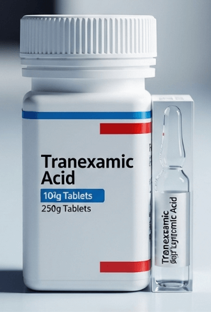Treatment Overview
Tranexamic acid (TXA) is widely used in Korean dermatology not only for pigmentation and melasma, but also as an emerging option for redness and flushing. TXA works by inhibiting plasmin activity, which reduces vascular inflammation, stabilizes blood vessels, and improves microcirculation. This dual action makes it effective for patients with rosacea, post-inflammatory erythema, and sensitive skin prone to flushing.
In Korea, tranexamic acid is offered in multiple forms: oral supplements, topical creams/ampoules, mesotherapy injections, and infusion therapy. Dermatologists often combine TXA with vascular lasers, pico lasers, cooling masks, or herbal soothing therapies for a more comprehensive redness-control program.
For redness and flushing, Tranexamic Acid Therapy:
- Reduces diffuse vascular redness.
- Improves post-acne erythema and rosacea symptoms.
- Strengthens vessel stability and reduces flushing triggers.
- Provides a non-steroid, non-antibiotic option for long-term control.
Purpose & Benefits
- Vascular Stability: Strengthens fragile vessels and reduces reactivity.
- Redness Reduction: Improves diffuse erythema and post-acne redness.
- Anti-Inflammatory Effect: Suppresses pathways that trigger flushing.
- Combination-Friendly: Works synergistically with lasers and barrier therapy.
- Versatile Options: Available as oral, topical, or injectable therapy in Korea.
Ideal Candidates
Tranexamic Acid Therapy in Korea is recommended for:
- Patients with rosacea-related redness and flushing.
- Individuals with post-acne erythema.
- Adults with sensitive, vascular-prone skin who cannot tolerate steroids.
- Patients seeking oral or topical alternatives to antibiotics or beta-blockers.
- Those looking for clinic-supervised combination therapy.
Comparison with Other Treatments
- Tranexamic Acid (Oral, Topical, Injectable): Reduces redness + pigmentation; vascular stabilizing effect.
- Anti-Redness Lasers (V-Beam, PDL, Nd:YAG): Directly target blood vessels; strongest for flushing.
- Pico Lasers: Improve diffuse redness + texture; gentle but less vascular-focused.
- Antibiotics (Doxycycline, Minocycline): Internal anti-inflammatory; not pigmentation-friendly.
- Beta-Blockers (Propranolol, Carvedilol): Reduce adrenaline-driven flushing; systemic only.
- Steroid Topicals: Emergency redness relief; short-term only.
- Herbal Soothing Therapy: Natural anti-inflammatory; good for maintenance.
Possible Risks & Complications
Tranexamic acid is safe when used under medical supervision, but may rarely cause:
- Mild stomach upset (oral form).
- Dryness or irritation (topical form).
- Temporary bruising or swelling (injection form).
- Increased clotting risk in patients with thromboembolic history (screening required).
Treatment Techniques Used
- Oral TXA: Low-dose capsules prescribed daily for 8–12 weeks.
- Topical TXA: Ampoules, creams, or serums applied once or twice daily.
- Mesotherapy Injections: Microinjections of TXA into redness-prone skin.
- Infusion Therapy: TXA delivered alongside vitamin or hydration infusions in-clinic.
- Combination Protocols: TXA paired with lasers, cooling masks, or herbal calming therapy for stronger outcomes.
Recovery & Aftercare
- Immediately After: Topical/injectable TXA calms irritation post-laser or peel.
- 2–4 Weeks: Redness and flushing begin to noticeably improve.
- Maintenance: Continued oral/topical use provides long-term vascular stability.
Aftercare Tips:
- Apply broad-spectrum sunscreen daily to prevent vascular flare-ups.
- Pair with hydrating serums and moisturizers to support barrier repair.
- Avoid alcohol and smoking, which worsen vascular sensitivity.
- Follow dermatologist guidance on oral TXA duration and dosing.
Results & Longevity
- Short-Term (2–4 Weeks): Flushing episodes decrease, redness begins to fade.
- Medium-Term (1–3 Months): Improved vascular stability and skin tone.
- Long-Term: With maintenance use, sustained reduction in redness and relapses.
Treatment Process in Korea
- Consultation & Diagnosis – Dermatologist evaluates type of redness (rosacea, post-acne erythema, diffuse flushing).
- Prescription/Selection – Oral, topical, or injectable TXA chosen.
- Application/Administration – TXA applied daily (topical), prescribed (oral), or injected (mesotherapy).
- Clinic Add-Ons – Often combined with anti-redness lasers, cooling masks, or herbal infusions.
- Follow-Up – Results monitored, dosage and therapy adjusted every few months.
Why Korea is a Top Destination
- Korea is a global leader in TXA-based pigmentation and redness protocols.
- Dermatologists tailor oral, topical, and injectable TXA for sensitive vascular skin.
- Multi-step programs integrate TXA with lasers, herbal soothers, and barrier repair.
- More affordable compared to Western dermatology centers.
- Korean skincare brands also lead in TXA-based serums and ampoules for at-home care.
Cost Range (Detailed Breakdown)
Pricing for Tranexamic Acid Therapy in Korea for redness & flushing:
- Consultation Fee: USD 20 – 40.
- Oral TXA (1-Month Prescription): USD 30 – 60.
- Topical TXA Serums/Ampoules: USD 40 – 100.
- Mesotherapy Injections (Per Session): USD 100 – 250.
- Premium Redness Program (TXA + Lasers + Infusions): USD 800 – 1,800 (3–5 sessions).
Additional Costs in Korea:
- Barrier creams and soothing serums: USD 30 – 80.
- Sunscreens for sensitive skin: USD 20 – 50.
💡 Patients often call tranexamic acid the “vascular stabilizer”, since it calms both redness and pigmentation while improving overall skin clarity.
Popular Clinics in Seoul
- Oracle Dermatology – TXA injections with V-Beam redness protocols.
- Banobagi Dermatology – Oral and topical TXA integrated into rosacea care.
- Renewme Skin Clinic – TXA mesotherapy with cooling mask aftercare.
- View Plastic & Dermatology – TXA ampoule infusions + laser programs for erythema.
- Chaum Anti-Aging Center – Premium TXA packages with regenerative infusions and vascular lasers.




